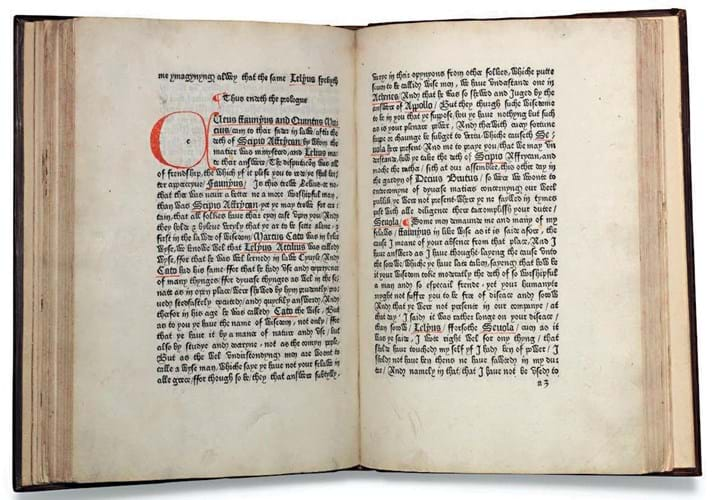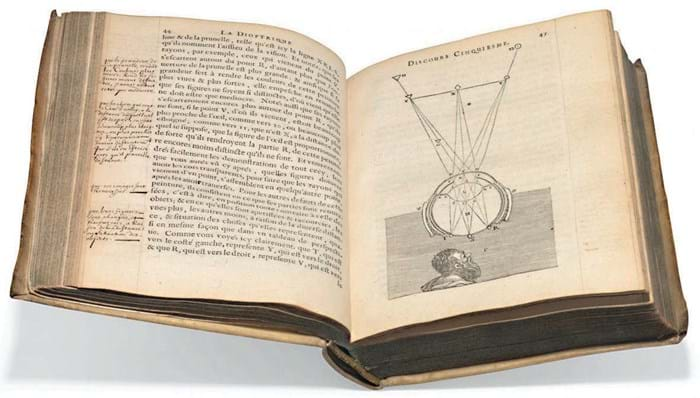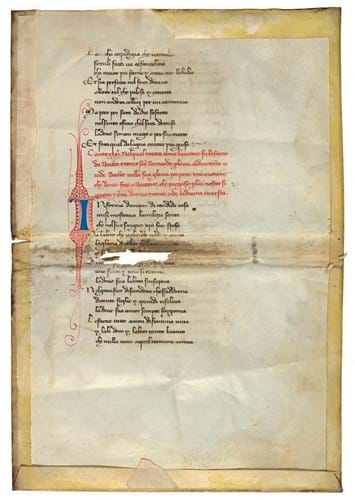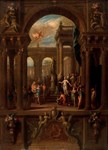
The sale's most expensive lot, at £320,000, was a volume whose contents not only included the first works of classical antiquity to be printed in England, but did so in the English language.
Produced by William Caxton in 1481, the principal works it contained were Cicero’s De senectute, or Of Old Age, as translated by Stephen Scrope and revised by William Worcester, and De amicitia, or Of Friendship, translated by John Tiptoft, Earl of Worcester. The volume also included just seven leaves from a copy of one of Caxton’s rarer imprints, his own translation of a work by Geoffroy de la Tour as The Knight of the Tower.
Also included in the volume was Tiptoft’s translation of a 14th century work by Bonaccursius de Montemagno as Of Nobility. The latter was written as guide for the author’s noble daughters in matters concerning their moral and social conduct.
Caxton had set up his printing press in the precincts of Westminster Abbey, c.1475, where his output was characterised by works in English, mostly literary, that were aimed at the upper echelons of society – wealthy merchants (like himself), gentry, nobility and royalty.

In a well-preserved contemporary English embroidered binding worked in silver wire over maroon velvet and studded with tiny sequins, and still retaining its original patterned ribbon marker, a little 1634, London edition of 'The Whole Book of Psalmes' made a much higher than expected £22,000 at Christie’s.
Darwin and Shakespeare
Also in this six-figure price category at the July 14 auction were an 1859 first of Darwin’s On the Origin of Species that almost doubled expectations to sell at £260,000 and a second-issue copy of the 1664, third folio issue of Shakespeare’s Comedies, Histories and Tragedies that reached £190,000.
Again, this was a much higher bid than predicted, and in 2000 this very copy of the plays had made just £24,000 in the same rooms.

Anonymous, but thought to have been produced in northern France or Flanders in the late 15th century, a handbook guide to the rules of heraldry containing some 800 armorials sold at £110,000 at Christie’s.
A 15th century heraldic manuscript sold for £110,000, as did a 1637 first of Descartes’ Discours de la méthode... in a contemporary Dutch binding of vellum over thin pasteboard with yapp edges, and featuring extensive marginalia in two different but contemporary hands.

A spread from the 1637 first of Descartes’ 'Discours de la méthode...' that realised £110,000 at Christie’s.
The Descartes work came from the extensive literary collections of David Wheeler, whose wife, Margita, had inherited (along with her brother) responsibility for Heveningham Hall in Suffolk, a great house that had been in the Vanneck family from the late 1770s.
In 1969 the Wheelers offered the house, complete with principal contents, to English Heritage, but this Descartes work was one of the items that they had held back at the time.
Sold at £85,000 apiece, and again well in excess of estimate, were works by Darwin once more and Einstein.
The former was a fine example, uncut in the original cloth, of the 1839 first edition of the four-volume Narrative of the Surveying Voyages of His Majesty’s Ships, Adventure and Beagle edited by expedition leader Robert Fitzroy but including as volume III the Journal and Remarks that are Darwin’s first published work.
The Einstein lot was a single page featuring an autograph draft (in German) of notes for a scientific paper on Unified Field Theory.

In the year that marks the 700th anniversary of Dante’s death, Christie’s offered a leaf from a mid-14th century vellum manuscript of 'La Divina Commedia'. This recently rediscovered fragment was once part of a manuscript belonging to the Florentine ‘Cento’ group, renowned for their uniformity of format, layout, decoration and script. It sold for a considerably higher than expected £70,000 at Christie's.
Austen poem
A very different lot was a poem in Jane Austen’s hand, one written in 1811 on the back of a now rather stained frontispiece leaf cut from an 1810 Minerva Press novel Love, Mystery and Misery.
Titled ‘On the Marriage of Mr Gell of East Bourn to Miss Gill’, it was probably inspired by a marriage notice she had found in the Hampshire Telegraph & Sussex Chronicle. It reads:
‘Of Eastbourn, Mr. Gell From being perfectly well Became dreadfully ill For the Love of a Miss Gill So he said with some sighs I’m the slave of your i.s Ah! restore if you please By accepting my e.s.’
At Sotheby’s in 1979, this rare example of Austen’s ventures into verse sold at £520. At Christie’s this year it was bid to a low-estimate £60,000.














